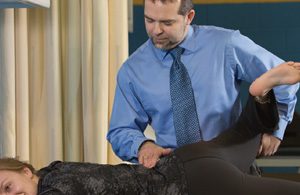How Strain-Counterstrain Can Help Your Pain
 Strain-counterstrain is hands-on treatment to help relieve pain from spasming or tight muscles. It was first created by an osteopathic physician and is still used by osteopathic physicians and physical therapists to relieve dysfunction.
Strain-counterstrain is hands-on treatment to help relieve pain from spasming or tight muscles. It was first created by an osteopathic physician and is still used by osteopathic physicians and physical therapists to relieve dysfunction.
Strain-counterstrain is a passive technique, which means you won’t be actively exercising or moving during the therapy. Instead, your physical therapist will guide your body into a position that is comfortable and hold your body there for a certain period of time. Repeated strain-counterstrain treatments can help relax muscles and stop pain.
Why Strain-Counterstrain Works
Strain-counterstrain relies on your physical therapist’s knowledge of musculoskeletal anatomy. When they find the muscle that is spasming, often through manual therapy, they then move you into a position to shorten that muscle. Your physical therapist will ask you if the position feels comfortable. Let them know if you feel any pain or discomfort in the position, as that may mean you aren’t in the right spot for optimal pain relief.
Once you are in position and comfortable, your physical therapist holds you there for at least 90 seconds. With the muscle shortened, your body may stop sending the nerve signals that were causing the muscle to pull tight and cause pain. Your muscle should relax, which can help relieve strain on other muscles and your joints.
After using strain-counterstrain, your therapist may use other manual techniques to loosen up muscle, including massage or gentle stretching. They may recommend you continue stretching at home to prevent muscle tightness from coming back.
Who Benefits from Strain-Counterstrain Therapy
Strain-counterstrain is a safe technique that can be used on almost anyone. It does not have side effects. It is especially appropriate for people experiencing tight muscles and often used to treat:
- Infants with torticollis (tight neck muscles that interfere with latching and movement)
- Older patients with arthritis or osteoporosis
- Patients with tight pelvic floor muscles, especially during pregnancy and post-partum
- Postoperative pain
Strain-counterstrain has many other uses for athletes and people of all ages. Your physical therapist can help you understand if this technique can help you feel and move better.
At Bon Secours In Motion, our physical therapists use a variety of hands-on techniques, including strain-counterstrain, to help relieve pain and improve function. If you are experiencing back pain, neck pain, leg pain or other issues, contact Bon Secours In Motion today to schedule your first appointment.

